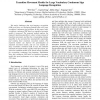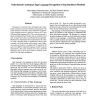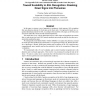27 search results - page 1 / 6 » Transition Movement Models for Large Vocabulary Continuous S... |
FGR
2004
IEEE
13 years 9 months ago
2004
IEEE
The major challenges that sign language recognition (SLR) now faces are developing methods that solve large vocabulary continuous sign problems. In this paper, large vocabulary co...
FGR
2002
IEEE
13 years 10 months ago
2002
IEEE
Hitherto, the major challenge to sign language recognition is how to develop approaches that scale well with increasing vocabulary size. In this paper we present an approach to la...
ICPR
2000
IEEE
13 years 9 months ago
2000
IEEE
This paper is concerned with a development of a videobased recognition system of continuous sign language. The system aimsfor an automatic signer dependent recognition of sign lan...
GW
1999
Springer
13 years 9 months ago
1999
Springer
In this paper we present a novel approach to continuous, whole-sentence ASL recognition that uses phonemes instead of whole signs as the basic units. Our approach is based on a se...
CVPR
2007
IEEE
14 years 7 months ago
2007
IEEE
One of the hard problems in automated sign language recognition is the movement epenthesis (me) problem. Movement epenthesis is the gesture movement that bridges two consecutive s...



